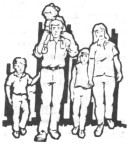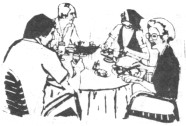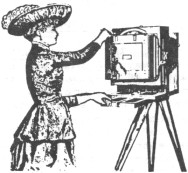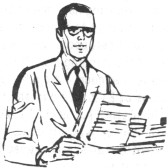How To Write A Good Show Report
by H. G. "Bee" Hyve
Reprinted from "Crown Jewels of the Wire", November 1986, page 36
Not everyone is a "born" writer; in fact, very few people are. Some
even study the art for years, and still can't master it. So when it comes to
writing a show report for Crown Jewels, many collectors simply do not know
where to start.
Show reports are extremely important. They inform collectors from all around
the globe as to what's happening in our hobby. Through that magic window called
Crown Jewels, a collector in Toowoomba, Australia can read about a show in
London, OH. Or, someone in Miami, FL can look at photos taken at a show in
Kirkland, WA. So, while they are not able to attend in person, they can still
"be there", just by reading the show report. Therefore, it is
important that show reports be "newsy" and of some length, and not
skimpy.

Listed below are a few guidelines to follow if the job of writing a show
report falls to you. Even experienced show reporters might want to see how they
can enrich and enhance their future offerings. There are a few basic subjects
that every show report should cover. The writer should always give, when
applicable:
1. WHICH SHOW YOURS IS IN A SERIES. If your show is the second or
more in a
series, you can list it as "the 2nd annual White Lake Insulator Show",
for example. (Did you know that technically, there cannot be a 1st annual
anything? Only after a show has been held a second year in a row can it become
an annual event!).
2. THE SPONSOR. Every show has a sponsor, whether it is a club, organization,
person, or persons. Be sure to give the name of those responsible for your show.
Often these hard-working and generous sponsors do not get the credit they
deserve.
3. THE LOCATION. This is important. Please always list the city and the
state. Those who attended the show will know where it was held, but those who
didn't, won't. Also, you might want to give the name of the facility where your
show was held; Twin Falls Firehall, Alta Mar Fairgrounds, Harvest Building, etc.
4. THE DATES. Always give the month, day(s) and year of your show. The year
might not seem important, but your show report might not appear in Crown Jewels
until the following year. For example, a show held in November 1986 might not be
reported until the February 1987 issue, so please give the full date. It will
then also become a permanent record or your show dates.
5. THE ATTENDANCE. Was it good, fair, poor? How was it compared to last
time? If it was poor, you probably won't want to say so. But attendance is one
item I've listed in order to give the show reporter an additional subject
about which to write.
6. THE NUMBER DF TABLES.

7. THE NUMBER DF DEALERS. Again, if your show was smaller than expected, you
might not want to list items 6 and 7. However, they are good items to list if
your show was successful, and would be or interest to those who didn't attend.
8. THE NUMBER OF STATES REPRESENTED. It might not always be possible to list
states represented at a local show. But it would be of interest for a regional
or national show.
9. THE NAMES OF COLLECTORS AND DEALERS IN ATTENDANCE. This is ok for small
shows, but be careful about listing them all for larger shows. A long list of
names might tend to bore those readers who didn't attend that particular show.
10. THE NUMBER OF DISPLAYS.
11. THE DISPLAY CATEGORIES.
12. THE DISPLAYERS' NAMES. These 3 items (10-12) arm always or interest to
readers or your report, no matter if they were in attendance or not. Along with
the award winners, give the names or every displayer, listing the display
category, display theme, and what in particular they displayed. Saying someone won in the "color"
category is really not enough. Saying that they won
with their all-blue collection would be better. The displayer's name is
important because although locally you all might know who displays Hemingray tolls,
3,000 miles away they might not know. Another point; when photographing
the displays, try to get the displayer to stand next to the display, so that
everyone will be able to see what he or she looks like.
13. THE AFTER-SHOW FESTIVITIES. Did your weekend include a Saturday night
dinner, banquet, or get-together? Did you all go to a local collector's home
to view their collection? If so, tell the rest or us about it. Maybe even
include some photos.

14. THE BEST (RARE OR SCARCE) INSULATORS SEEN OR SOLD AT THE SHOW. Did an
emerald green Busby appear on a dealer's table? Or a cobalt blue castle? Or
did a little old lady walk in with a gunny-sack full of mint lemon yellow Plutos? If
so, mention it in your report, along with photos, if possible. Those
who couldn't attend your show would simply love to hear about it.
15. THE NAMES OF OLD-TIME COLLECTORS IN ATTENDANCE AFTER A LONG ABSENCE. Did someone
show up who hasn't collected since 1972? Why not tell the rest of us? We may
have known him or her years ego, and always wondered what happened to them. If
you mention them in your report, maybe now we can locate them and renew an old friendship.
16. THE WEATHER. How was the weather during your show, and was it a factor
(for good or bad) in the attendance? Did it rain, snow, sleet, or hail? Was there a heat
spell? Was there any other event (hurricane, earthquake, fire)
nearby that added pizzazz to your weekend? If so, that bit of news would interest your
readers.
Well, that covers a lot if items which you could and should include in your show report, to help you make it full and informative. Now hare are a few
additional tips as to the handling of the report itself:
1. Take lots of good photos. It's better to have to choose from a big bunch,
than to not have enough. Black and white photos are preferred, but good sharp,
contrasting color photos can be used also.
2. Type your show report if possible, and use double-spacing. Otherwise,
print or write vary clearly, so that Carol or her "translators" will
know what you meant to say! Remember, your report is only one of many they must
transcribe, so be neat and make it easier on their eyes. (And don't worry about
your spelling or grammar. Any glaring defects will be corrected).

3. Endeavor to use different or unusual words and phrases; make your report
unique. There are many ways to say the same thing. For example, instead of saying, "It rained all weekend", why not
say, "The rain certainly didn't dampen the enthusiasm of the collectors."?
Or, "This show drew quite
a number of new faces," instead of, "There ware many new collectors
there." Use a dictionary; search for colorful and rarely-used words
and phrases, but keep it simple. Not everyone reading your report is a rocket
scientist!
4. Be prompt in sending your report and photos to Carol. Old news is not as
interesting as fresh news. Even those who went to your show will want to read
about it as soon as possible, and not 6-8 months afterward. However, if
circumstances make it impossible for you to get your report in right away, it's
always "better late than never". Your report should be sent in within
14 days after the show ends, and should be received before the first of the
month to be included in the following month's issue (space permitting).
I've seen many shows listed in the "Calendar" section of Crown
Jewels for which no report was ever written. Maybe these tips will help, and
more reports will surface. It isn't that difficult at all. If all you did was
list the information in items 1-16, you'd have a fairly newsy report, even
without any elaboration. Keep in mind that a show report is a good advertisement
for your show, and could do a lot toward boosting attendance for your next
endeavor.

There are scores of good show reports in Crown Jewels, but here are 2
examples you could follow. To read a truly newsy, colorful, and fine piece of
show reporting, see Claude Wambold's report of the Kulpsville, PA show in
Crown Jewels 1-86-26. Here you find interesting words and phrases, bits of
information unique to that particular show, and lots of clear photos with
identifying labels. The report is well-written, informative, and concise. It
tells it all, and yet does not ramble. As a second example, any show report
written by Bob and Phoebe Adams is always newsy, well-written, and includes all
necessary and important information. They usually answer the 5 important
questions any good news reporter should answer; who, what, when, where, and why?
In conclusion, please remember that the information presented herein is just
a guide. For your show report you can arrange the material in items 1-16 (or any
additional material you might think of) in any order you choose. But try to
Include all items when possible. Shows, whether large or small, are a tremendous
amount of work for someone. So why not "tell the world" that you had a
show? We all would enjoy reading about it. And after reading about It, who
knows? Maybe next time that person who stayed home will make a greater effort to
attend!
| 